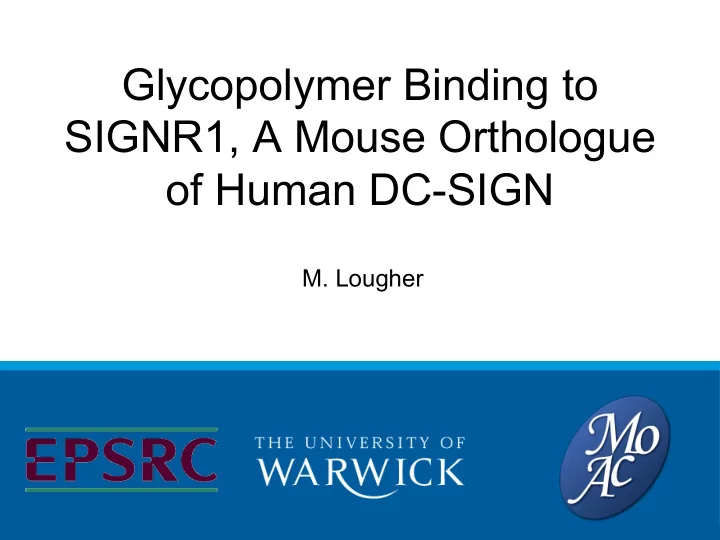

Glycopolymer Binding to SIGNR1, A Mouse Orthologue of Human DC-SIGN M. Lougher
Contents • DC-SIGN • Glycopolymers • Why Use SIGNR1? • Surface Plasmon Resonance • Results • Conclusions 2
DC-SIGN • Membrane protein found in dendritic cells and some types of macrophages. • Receptor cells of this type traditionally bind to pathogens and present them to T-cells for destruction. • DC-SIGN binds to HIV and presents that to T- cells, but instead of being digested the HIV infects the T-cell. 1 3 1. H. Feinberg et al ., J. Mol. Biol., 394 , 613–620 (2009)
DC-SIGN • C-type lectin; binds to mannose rich pathogens. • GP120 in HIV envelope has mannose groups. • Aim to design prophylactic treatment that binds to the carbohydrate recognition domain (CRD) and prevents GP120 from binding. • One possible solution is glycopolymers. 1 4 1. H. Feinberg et al ., J. Mol. Biol., 394 , 613–620 (2009)
Glycopolymers • Polymer chain with sugar groups attached. • Used 3 different shape polymers each bound with multiple mannose groups. Straight Chain 8 Arm (DP60) 5 Arm 5
Why Use SIGNR1? • Mouse orthologue of DC-SIGN. • Test to see if experiments on mice would be relevant to research for human treatment. • Would allow research without using human tissue; much easier to carry out. • Need to test to see if binding of glycopolymers is comparable both in-vitro and in-vivo. 6
Surface Plasmon Resonance • Method of detecting binding to a thin gold surface as refractive index changes. 2 7 2. M. Cooper, Nature Reviews Drug Discovery 1 , 515-528 (2002)
Results • MAN DP60 8
Results • MAN-8ARM 9
Results • MAN-5ARM 10
Results • Regeneration 11
Results • Flow Cytometry 12
Results • Cytotoxicity 13
Summary • MAN DP60 shown to bind well to DC-SIGN and SIGNR1. • Further work needed for conclusive results of MAN-5ARM and MAN-8ARM. • Demonstrated cytokines increase binding to cells. • Shown that polymers are not toxic to cells in concentrations used. • Binding profiles similar for SIGNR1 and DC-SIGN; mouse disease models can be used to develop human treatment. 14
Acknowledgements • Thanks to: – Dan Mitchell – Remzi Becer – Tariq Pathan – Rob Deller – Florence Hariton • Funded by: – MOAC – EPSRC 15
Recommend
More recommend